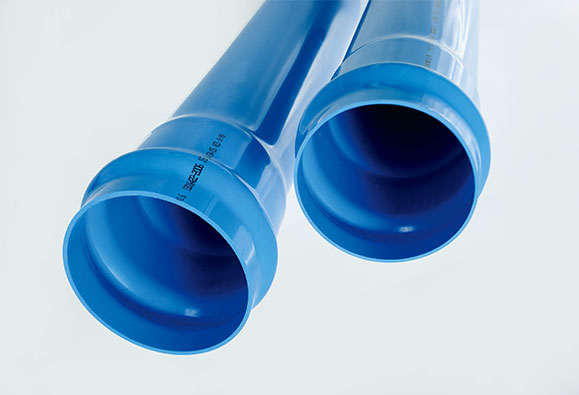Category:Municipal plumbing
Introduction:
PVC-O pipe, also known as biaxially stretched pipe, is a new type of pressure-bearing pipe obtained by axially and circumferentially stretching (biaxially stretched) traditional PVC-U pipe in a high elastic state. Its advantage is that through the biaxial stretching of the material, the molecular chain of the material changes from a linear structure before stretching to a network structure after stretching, so that the pressure resistance of PVC-O pipes is improved compared with traditional PVC-U pipes. Nearly double, the low temperature impact resistance and stress cracking resistance are 5 times that of PVC-U pipe.PVC-O pipe, also known as biaxially stretched pipe, is a new type of pressure-bearing pipe obtained by axially and circumferentially stretching (biaxially stretched) traditional PVC-U pipe in a high elastic state. Its advantage is that through the biaxial stretching of the material, the molecular chain of the material changes from a linear structure before stretching to a network structure after stretching, so that the pressure resistance of PVC-O pipes is improved compared with traditional PVC-U pipes. Nearly double, the low temperature impact resistance and stress cracking resistance are 5 times that of PVC-U pipe.
The hoop stretching of the PVC-O pipe makes the inner diameter of the pipe larger and the wall thickness thinner, thereby obtaining a larger water passage area. The inner wall of the pipe is particularly smooth, which reduces the head loss along the way, and the inner wall does not scale.
Compared with traditional pipes, under the same nominal outer diameter and pressure (1,6MPa), PVC-O pipes increase the water transport capacity by 15% -35%, which means that PVC-O pipes increase the water transport capacity, but consume energy reduce.

Executive standard: International standard ISO16422: 2006
Material Grade | Design factor C=1.6 nominal pressure | ||||||||||||
315 | 6.3 |
| 8 |
| 10 |
| 12.5 |
| 16 |
| 20 |
| 25 |
355 |
| 8 |
| 10 |
| 12.5 |
| 16 |
| 20 |
| 25 |
|
400 | 8 |
| 10 |
| 12.5 |
| 16 |
| 20 |
| 25 |
|
|
450 |
| 10 |
| 12.5 |
| 16 |
| 20 |
| 25 |
|
|
|
500 | 10 |
| 12.5 |
| 16 |
| 20 |
| 25 |
|
|
|
|
| Design factor C=1.4 nominal pressure | ||||||||||||
450 | 10 |
| 12.5 |
| 16 |
| 20 |
| 25 |
| 20 |
| 20 |
500 |
| 12.5 |
| 16 |
| 20 |
| 25 |
| 20 |
| 25 |
|
| Design factor C=2.0 nominal pressure | ||||||||||||
315 | 5 |
| 6.3 |
| 8 |
| 10 |
| 12.5 |
| 16 |
| 20 |
355 |
| 6.3 |
| 8 |
| 10 |
| 12.5 |
| 16 |
| 20 |
|
400 | 6.3 |
| 8 |
| 10 |
| 12.5 |
| 16 |
| 20 |
| 25 |
450 |
| 8 |
| 10 |
| 12.5 |
| 16 |
| 20 |
| 25 |
|
500 | 8 |
| 10 |
| 12.5 |
| 16 |
| 20 |
| 25 |
|
|
Tube Series S Calculated and Standard Size Ratio SDR | |||||||||||||
S | 32.0 | 28.0 | 25.0 | 22.4 | 20.0 | 18 | 16.0 | 14 | 12.5 | 11.2 | 10.0 | 9.0 | 8.0 |
Scale | 31.623 | 28.184 | 25,119 | 22.387 | 19.953 | 17.783 | 15.849 | 14.125 | 12.589 | 11,220 | 10.000 | 8.9125 | 7.9433 |
SDR | 65.0 | 57.0 | 51.0 | 45.8 | 41.0 | 37 | 33.0 | 29.0 | 26.0 | 23.4 | 21.0 | 19.0 | 17.0 |
Dn | Wall thickness e”mm | ||||||||||||
63 |
|
|
|
| 1.6 | 1.8 | 2.0 | 2.2 | 2.5 | 2.7 | 3.0 | 3.4 | 3.8 |
75 |
|
| 1.5 | 1.7 | 1.9 | 2.1 | 2.3 | 2.6 | 2.9 | 3.2 | 3.6 | 4.0 | 4.5 |
90 |
| 1.6 | 1.8 | 2.0 | 2.2 | 2.5 | 2.8 | 3.1 | 3.5 | 3.9 | 4.3 | 4.8 | 5.4 |
110 | 1.8 | 2.0 | 2.2 | 2.4 | 2.7 | 3.1 | 3.4 | 3.8 | 4.2 | 4.7 | 5.3 | 5,9 | 6.6 |
125 | 2.0 | 2.2 | 2.5 | 2.8 | 3.1 | 3.5 | 3.9 | 4.3 | 4.8 | 5.4 | 6.0 | 6.7 | 7.4 |
140 | 2.2 | 2.5 | 2.8 | 3.1 | 3.5 | 3.9 | 4.3 | 4.8 | 5.4 | 6.0 | 6.7 | 7.5 | 8.3 |
160 | 2.5 | 2.8 | 3.2 | 3.5 | 4.0 | 4.4 | 4.9 | 5.5 | 6.2 | 6.9 | 7.7 | 8.5 | 9.5 |
180 | 2,8 | 3.2 | 3.6 | 4,0 | 4.4 | 5.0 | 5.5 | 6.2 | 6.9 | 7.7 | 8.6 | 9.6 | 10.7 |
200 | 3.2 | 3.5 | 3.9 | 4.4 | 4.9 | 5.5 | 6.2 | 6.9 | 7.7 | 8.6 | 9.6 | 10.7 | 11.9 |
225 | 3.5 | 4.0 | 4.4 | 5.0 | 5.5 | 6.2 | 6.9 | 7.7 | 8.6 | 9.6 | 10.8 | 12.0 | 13.4 |
250 | 3.9 | 4.4 | 4.9 | 5.5 | 6.2 | 6.9 | 7.7 | 8.6 | 9.6 | 10.7 | 11.9 | 13.3 | 14.8 |
280 | 4.4 | 4.9 | 5.5 | 6.2 | 6.9 | 7.7 | 8.6 | 9.6 | 10.7 | 12.0 | 13.4 | 14.9 | 16.6 |
315 | 4.9 | 5.5 | 6.2 | 6.9 | 7.7 | 8.7 | 9.7 | 10.8 | 12.1 | 13.5 | 15.0 | 16.8 | 18.7 |
355 | 5.6 | 6.2 | 7.0 | 7.8 | 8.7 | 9.8 | 10.9 | 12.2 | 13.6 | 15.2 | 16.9 | 18.9 | 21.1 |
400 | 6.3 | 7.0 | 7.9 | 8.8 | 9.8 | 11.0 | 12.3 | 13.7 | 15.3 | 17.1 | 19.1 | 21.3 | 23.7 |
450 | 7.0 | 7.9 | 8.8 | 9.9 | 11.0 | 12.4 | 13.8 | 15.4 | 17.2 | 19.2 | 21.5 | 23.9 | 26.7 |
500 | 7.8 | 8.8 | 9.8 | 11.0 | 12.3 | 13.7 | 15.3 | 17.1 | 19.1 | 21.4 | 23.9 | 26.6 | 29.7 |
560 | 8.8 | 9.8 | 11.0 | 12.3 | 13.7 | 15.4 | 17.2 | 19.2 | 21.4 | 23.9 | 26.7 | 29.8 | 33.2 |
630 | 9.9 | 11.0 | 12.3 | 13.8 | 15.4 | 17.3 | 19.3 | 21.6 | 24.1 | 26.9 | 30.0 | 33.5 | 37.4 |
1. Low temperature impact resistance: PVC-O pipes perform more prominently at low temperatures. Even at -25C, the impact resistance of PVC-O pipes will not be significantly reduced, thus expanding the application area of PVC-O pipes and extending the window period of pipeline construction.
Comparison table of drop weight impact test conditions of PVC-O and PVC-U pipes
Nominal outside diameter(DN, mm) | PVC-0 | PVC-U | ||
Drop weight mass(kg) | Height(m) | Drop weight mass(kg) | Height(m) | |
90 | 6 | 2 | 0.8 | 1,2 |
110 | 6.3 | 2 | 1.0 | 1.6 |
125 | 6.3 | 2 | 1.25 | 2 |
140 | 8 | 2 | 1.6 | 1.8 |
160 | 8 | 2 | 1.6 | 2 |
180 | 10 | 2 | 2.0 | 1.8 |
200 | 10 | 2 | 2.0 | 2 |
225 | 12.5 | 2 | 2.5 | 1.8 |
2. Stress crack resistance
The mesh-like laminated structure of PVC-O pipe hinders the passage of cracks in each layer, effectively preventing the spread of cracks, thereby eliminating the risk of rapid cracking of the pipe wall.

3. Anti-fatigue properties
When the material is subjected to internal pressure for a long time, the mechanical properties of the material will be attenuated. This characteristic is the creep behavior. The creep of the PVC-0 material is very small. This means that compared to traditional plastics, PVC-0 pipes have extraordinary fatigue resistance and can last up to a hundred years.

4. Flexibility
Due to the excellent elasticity of PVC-O pipe, the deformation it can withstand can reach 100% of the inner diameter of the pipe. When the pipe is squeezed or a mechanical accident occurs, it can immediately return to its original shape.

This minimizes the risk of rupture due to soil settlement, sharp sand or mechanical extrusion during construction.
5. Excellent water hammer resistance
PVC-O pipe has thinner walls and larger inner diameter, so the wave velocity of PVC-O pipe is lower (four times lower than ductile iron) compared to other piping systems. When there is a sudden change in the volume and pressure of the conveyed water, the resulting water hammer is low. Therefore, when the valve and pump are opened and closed, the adverse effect of water hammer on the pipeline operation is reduced, and the pipeline network operation is more stable.
Mechanical properties of PVC-O pipes and traditional plastic pipes
Performance | PVC-O 450 | PVC-U | HDPE100 | |
Product Standards | Unit | CJ/T445-2014 | GB/T10002.1-2006 | GB/T13663-2000 |
Minimum required strength | MPa | 45 | 25 | 10 |
Overall usage factor C |
| 1.4/1.6 | 2.0 | 1.25 |
Design stress. S | MPa | 32/28 | 12.5 | 8 |
Short-term elastic modulus E | MPa | >4000 | N3000 | N1000 |
Axial tensile strength | MPa | >48 | N48 | 19 |
Hoop tensile strength | MPa | N85 | n48 | 19 |
PVC-O pipes are produced according to the standard of "Impact and Compression Biaxially Oriented Polyvinyl Chloride (PVC-O) Pipes and Connectors for Water Supply" (CJ/T445-2014 IDT 13016422:2006).
With its excellent performance, PVC-O pipes can be widely used in municipal pipe networks, urban water supply pipe networks, rural water conservancy systems, long-distance water pipeline networks and other market fields.






 Wechat QR code
Wechat QR code
 Home
Home Tel
Tel Product
Product